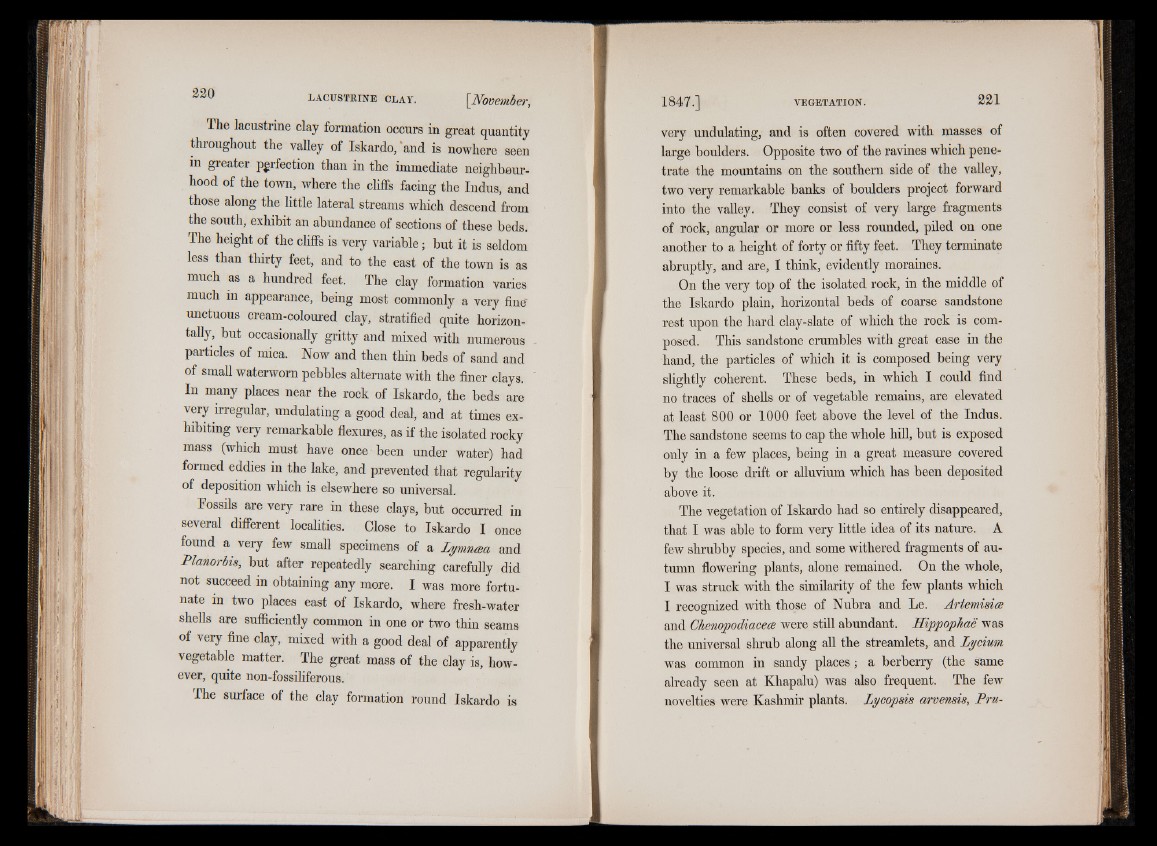
The lacustrine clay formation occurs in great quantity
throughout the valley of Iskardo, ‘and is nowhere seen
in greater perfection than in the immediate neighbourhood
of the town, where the cliffs facing the Indus, and
those along the little lateral streams which descend from
the south, exhibit an abundance of sections of these beds.
The height of the cliffs is very variable; but it is seldom
less than thirty feet, and to the east of the town is as
much as a hundred feet. The clay formation varies
much in appearance, being most commonly a very fine'
unctuous cream-coloured clay, stratified quite horizon-
tally, but occasionally gritty and mixed with numerous
particles of mica. Now and then thin beds of sand and
of small waterwom pebbles alternate with the finer clays.
In many places near the rock of Iskardo, the beds are
very irregular, undulating a good deal, and at times exhibiting
very remarkable flexures, as if the isolated rocky
mass (which must have once been under water) had
formed eddies in the lake, and prevented that regularity
of deposition which is elsewhere so universal.
Fossils are very rare in these clays, but occurred in
several different localities. Close to Iskardo I once
found a very few small specimens of a Lymncea and
Planorbis, but after repeatedly searching carefully did
not succeed in obtaining any more. I was more fortunate
m two places east of Iskardo, where fresh-water
shells are sufficiently common in one or two thin seams
of very fine clay, mixed with a good deal of apparently
vegetable matter. The great mass of the clay is, however,
quite non-fossiliferous.
The surface of the clay formation round Iskardo is
very undulating, and is often covered with masses of
large boulders. Opposite two of the ravines which penetrate
the mountains on the southern side of the valley,
two very remarkable banks of boulders project forward
into the valley. They consist of very large fragments
of rock, angular or more or less rounded, piled on one
another to a height of forty or fifty feet. They terminate
abruptly, and are, I think, evidently moraines.
On the very top of the isolated rock, in the middle of
the Iskardo plain, horizontal beds of coarse sandstone
rest upon the hard clay-slate of which the rock is composed.
This sandstone crumbles with great ease in the
hand, the particles of which it is composed being very
slightly coherent. These beds, in which I could find
no traces of shells or of vegetable remains, are elevated
at least 800 or 1000 feet above the level of the Indus.
The sandstone seems to cap the whole hill, but is exposed
only in a few places, being in a great measure covered
by the loose drift or alluvium which has been deposited
above it.
The vegetation of Iskardo had so entirely disappeared,
that I was able to form very little idea of its nature. A
few shrubby species, and some withered fragments of autumn
flowering plants, alone remained. On the whole,
I was struck with the similarity of the few plants which
I recognized with those of Nubra and Le. Artemisia
and Chenopodiacece were still abundant. Hippophae was
the universal shrub along all the streamlets, and Lycimn
was common in sandy places; a berberry (the same
already seen at Khapalu) was also frequent. The few
novelties were Kashmir plants. Lycopsis arvensis, Pru